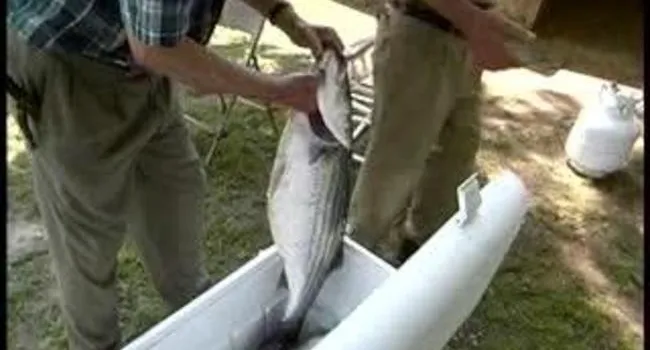
Document

Along the rivers of northeast North Carolina, folks serve rockfish muddle out of large black iron pots. The “muddle” is a thick fish stew made with spring onions, yellow onions, parsley, bacon, crushed red pepper and a few potatoes. Sometimes the bacon grease is added for extra flavor. In addition to rockfish (striped bass), catfish are also used. According to Howarton Finch, local muddle maker, it takes two 30-lb rockfish to make a good-sized muddle. Doug Brown traces the history of making muddles to his grandfather’s era, who fed it to him as a baby.
The muddle is a close cousin to fish chowders, perloos, and chicken bog. The traditional muddle recipe was far from complex and despite humble origins, some contemporary recipes include ingredients like white wine, leeks, celery, and fresh tarragon. Historically, muddles are cooked when the fish are “running” or swimming upriver to spawn. After catching the fish—rockfish are common—they are cleaned and cooked right on the riverbank in large cast iron pots. Unlike Brunswick Stew or Burgoo, these stews are cooked down to the point they resemble a thick mush or porridge. Similar to bogs and perloo (from the French pilau), rice or potatoes provide the thickening agent in a muddle. Most fish chowders, like the catfish chowder of the South Carolina Sea Island tradition, do not include potatoes or rice and have a much thinner consistency.
Like other one-pot traditions, a muddle is a communal dish - a food of congregation. Easily prepared for large groups of people, muddles are typically a fixture at political rallies, church homecomings, festivals, and community gatherings. The social connections are so strong that, like the term barbecue, “muddle” is used to refer to the actual gathering, as well as the dish itself. Recently, due to a severe drop in the rockfish population, chicken has come to be a popular replacement for the traditional inclusion of fish. The practice of cooking the muddle on riverbanks in large cast-iron pots has largely faded as well. This mirrors the decline in backyard “shade tree” hash preparation in South Carolina. While no longer as common on the riverbanks of North Carolina, the fish muddle remains a staple culinary delight at festivals, stump meetings, family reunions, and church homecomings.

Document

Video

Video

Video

Video